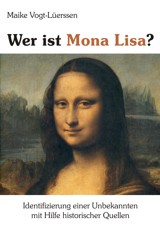This weblog was originally published in January 2019.
The year 2019 is a very special year, because we will celebrate the 500th anniversary of Leonardo da Vinci's death. Therefore I need your help, my dear readers, otherwise we will hear the untrue stories about Leonardo da Vinci again, which were made up by so-called intellectual men of the 19th and the first half of the 20th century who thought of themselves they were all “little Leonardo da Vincis” and the latter had therefore also to share their love for “little boys with curly hair”.
Please, inform your friends and relatives about the mourning dress of the Sforza duchesses and the many special symbols of the Visconti and Sforza. Tell them about my book “Who is Mona Lisa?”: http://www.kleio.org/de/buecher/wer-ist-mona-lisa/ And about the fact that who knows the traditions of the past, knows definitely more!
Did you for example know that no man of illegitimate birth could become a Master of his craft in the Middle Ages and the Renaissance? Nobody!!! How did Leonardo manage to become a Master although he was born out of wedlock as you all know? What happened in his life? Who adopted him?
Did you know that all painters in the Middle Ages and the Renaissance were trained to paint with the right hand? The left one was “the bad hand” until the second half of the 20th century. Do you like me remember how schoolfellows of you who were left-handed were trained to use their right hand? We even have a contemporary of Leonardo da Vinci who met him in October 1517, Antonio de Beatis, who told us that Leonardo da Vinci “can't paint any longer, because he can't use his right hand any longer” (he had a heart attack or stroke at the beginning of the year 1516). And nowadays the so-called specialists of Leonardo da Vinci who spent not one minute in the workshop of the latter tell us he painted only with the left hand. No wonder that many paintings made by Leonardo da Vinci are attributed to Boltraffio, Raphael etc.
Did you know that the people in the Middle Ages and the Renaissance were buried one day after they died? The only exceptions we had were the people of the very high nobility. They were cut open to remove the organs (to stop the decomposition) which were replaced with perfumes and fragrant herbs. Their bodies were buried one, two, sometimes even three weeks later, so that their friends from the other high dynasties could be present at their funerals. Leonardo died on the 2nd May 1519 and was supposedly buried on the 12th August 1519. What did really happen with his body? Here for example the death and burial of the French King Louis XII in January 1515: "Late on January 1, between the hours of ten and eleven [at night], he [the French King Louis XII] died ... On January 2, Louis's entrails and heart were removed and buried separately in urns in the Church of the Celestins, the special church of the House of Orléans in Paris, while the rest of his corpse was embalmed and taken to lie in state in the Tournelles ... On January 11, the body was removed to Notre-Dame for a solemn funeral Mass ... The following day [12 January] the body was taken to St. Denis ... The coffin remained in the church overnight, and the next morning [13 January] 25 Scots archers carried it down into the dark crypt that served as the final resting place for French royalty." (in: Frederic J. Baumgartner: Louis XII. New York 1996, pp. 243-244).
Leonardo da Vinci was supposedly a court painter of the French King François I from 1517 to 1519 (not already in 1516 – we have contemporary sources telling us he was still in Italy). But what is a court painter worth who was not any longer able to paint (because of the heart attack or stroke in 1516)? Therefore Leonardo's friend Andrea del Sarto did his job as painter. What was the real purpose of Leonardo da Vinci to be in France and who sent him there and why?
The answers to these questions you will find in my book: Die Sforza III: Isabella von Aragon und ihr Hofmaler Leonardo da Vinci: http://www.kleio.org/de/buecher/isabella/



